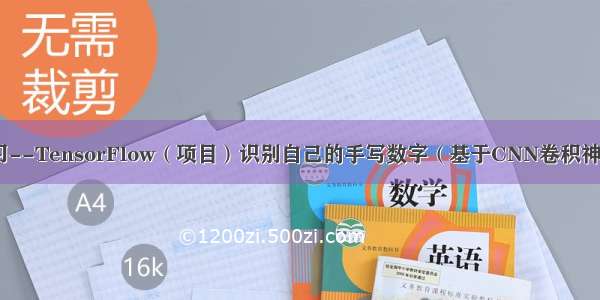
手写汉字数字识别(构建数据集+CNN神经网络)
期末,P老师布置了一个大作业,自己构建数据集实现手写汉字数字的识别。太捞了,记录一下过程。大概花了一个下午加半个晚上,主要是做数据集花时间。
一、构建数据集——使用h5py
1.收集数据,这部分由我勤劳的室友们一起手写了800个汉字 一、二、三、四、五、六、七、八、九、十完成。这部分也没啥好说的,慢慢写呗。我们用了IPAD,然后截图,这样出来的图片质量比较好。
2.对图像进行处理。将图像转化为(64,64,3)的矩阵,对图像批量编号及分类。这里新建了一个py文件,代码如下。
import h5pyimport osimport numpy as npfrom PIL import Imageimport tensorflow as tfimport matplotlib.pyplot as pltimport sklearnfrom sklearn import preprocessingimport scipy#未处理图片位置orig_picture = r'C:\Users\10595\Desktop\dataset\image'#已处理图片存储位置gen_picturn = r'C:\Users\10595\Desktop\dataset\data'#查询需要分类的类别以及总样本个数classes = ["one","two","three","four","five","six","seven","eight","nine","ten"]def get_traindata(orig_dir,gen_dir,classes):i = 0for index,name in enumerate(classes):class_path = orig_dir + '\\' + name + '\\' #扫描原始图片gen_train_path = gen_dir +'\\' + name #判断是否有文件夹folder = os.path.exists(gen_train_path)if not folder :os.makedirs(gen_train_path)print(gen_train_path,'new file')else:print('There is this flie')#给图片加编号保存for imagename_dir in os.listdir(class_path):i += 1origimage_path = class_path + imagename_dir#统一格式image_data = Image.open(origimage_path).convert('RGB')image_data = image_data.resize((64,64))image_data.save(gen_train_path + '\\' + name + str(i) + '.jpg' )num_samples = iprint('picturn :%d' % num_samples)if __name__ == '__main__':get_traindata(orig_picture,gen_picturn,classes)
3.使用h5py将图像打包成数据集
import osimport numpy as npfrom PIL import Imageimport h5pyimport scipyimport matplotlib.pyplot as plt#搞了十个我也很困惑,不知道有什么简便方法one = []label_one = []two = []label_two = []three = []label_three = []four = []label_four = []five = []label_five = []six = []label_six = []seven = []label_seven = []eight = []label_eight = []nine = []label_nine = []ten = []label_ten = []def get_files(file_dir):for file in os.listdir(file_dir + '\\' + 'one'):one.append(file_dir +'\\'+'one'+'\\'+ file) label_one.append(0)for file in os.listdir(file_dir + '\\' + 'two'):two.append(file_dir +'\\'+'two'+'\\'+ file) label_two.append(1)for file in os.listdir(file_dir + '\\' + 'three'):three.append(file_dir +'\\'+'three'+'\\'+ file) label_three.append(2)for file in os.listdir(file_dir + '\\' + 'four'):four.append(file_dir +'\\'+'four'+'\\'+ file) label_four.append(3)for file in os.listdir(file_dir + '\\' + 'five'):five.append(file_dir +'\\'+'five'+'\\'+ file) label_five.append(4)for file in os.listdir(file_dir + '\\' + 'six'):six.append(file_dir +'\\'+'six'+'\\'+ file) label_six.append(5)for file in os.listdir(file_dir + '\\' + 'seven'):seven.append(file_dir +'\\'+'seven'+'\\'+ file) label_seven.append(6)for file in os.listdir(file_dir + '\\' + 'eight'):eight.append(file_dir +'\\'+'eight'+'\\'+ file) label_eight.append(7)for file in os.listdir(file_dir + '\\' + 'nine'):nine.append(file_dir +'\\'+'nine'+'\\'+ file) label_nine.append(8)for file in os.listdir(file_dir + '\\' + 'ten'):ten.append(file_dir +'\\'+'ten'+'\\'+ file) label_ten.append(9)#把所有数据集进行合并image_list = np.hstack((one,two,three,four,five,six,seven,eight,nine,ten))label_list = np.hstack((label_one,label_two,label_three,label_four,label_five,label_six,label_seven,label_eight,label_nine,label_ten))#利用shuffle打乱顺序temp = np.array([image_list, label_list])temp = temp.transpose()np.random.shuffle(temp)#从打乱的temp中再取出list(img和lab)image_list = list(temp[:, 0])label_list = list(temp[:, 1])label_list = [int(i) for i in label_list] return image_list,label_listtrain_dir = r'C:\Users\10595\Desktop\dataset\data'image_list,label_list = get_files(train_dir)Train_image = np.random.rand(len(image_list)-50, 64, 64, 3).astype('float32')#这里50为测试集,根据需求改Train_label = np.random.rand(len(image_list)-50, 1).astype('int')Test_image = np.random.rand(50, 64, 64, 3).astype('float32')Test_label = np.random.rand(50, 1).astype('int')for i in range(len(image_list)-50):Train_image[i] = np.array(plt.imread(image_list[i]))Train_label[i] = np.array(label_list[i])for i in range(len(image_list)-50, len(image_list)):Test_image[i+50-len(image_list)] = np.array(plt.imread(image_list[i]))Test_label[i+50-len(image_list)] = np.array(label_list[i])f = h5py.File('data.h5', 'w')f.create_dataset('X_train', data=Train_image)f.create_dataset('y_train', data=Train_label)f.create_dataset('X_test', data=Test_image)f.create_dataset('y_test', data=Test_label)f.close()#文件生成在此py文件同一文件夹下
这样我们就得到了一个.h文件,里面存放着我们的图片信息。
二、使用CNN进行训练预测
以下均是在Jupyter Notebook 中实现滴~
import mathimport numpy as npimport h5pyimport matplotlib.pyplot as pltimport scipyfrom PIL import Imagefrom scipy import ndimageimport tensorflow as tffrom tensorflow.python.framework import opsfrom cnn_utils import *#载入我们刚才制作的h5数据集train_dataset = h5py.File('data.h5', 'r')X_train_orig = np.array(train_dataset['X_train'][:])Y_train_orig = np.array(train_dataset['y_train'][:]) X_test_orig = np.array(train_dataset['X_test'][:])Y_test_orig = np.array(train_dataset['y_test'][:])X_train = X_train_orig/255.X_test = X_test_orig/255.#归一化
让我们来康康我们做的数据集长得怎么样
t = 5plt.imshow(X_train[t])print("y = "+str(np.squeeze(Y_train_orig[t])+1))
#确认一下数据集的大小Y_train_orig = Y_train_orig.TY_test_orig = Y_test_orig.TY_train = convert_to_one_hot(Y_train_orig, 10).TY_test = convert_to_one_hot(Y_test_orig, 10).Tprint ("number of training examples = " + str(X_train.shape[0]))print ("number of test examples = " + str(X_test.shape[0]))print ("X_train shape: " + str(X_train.shape))print ("Y_train shape: " + str(Y_train.shape))print ("X_test shape: " + str(X_test.shape))print ("Y_test shape: " + str(Y_test.shape))conv_layers = {}print(Y_train[5])#开始Tensorflowdef create_placeholders(n_H0, n_W0, n_C0, n_y):X = tf.placeholder(tf.float32, shape=[None, n_H0, n_W0, n_C0])Y = tf.placeholder(tf.float32, shape=[None, n_y])return X, YX, Y = create_placeholders(64, 64, 3, 10)print ("X = " + str(X))print ("Y = " + str(Y))def initialize_parameters():tf.set_random_seed(1)# so that your "random" numbers match oursW1 = tf.get_variable("W1", [4, 4, 3, 8], initializer=tf.contrib.layers.xavier_initializer(seed=0))W2 = tf.get_variable("W2", [2, 2, 8, 16], initializer=tf.contrib.layers.xavier_initializer(seed=0))W3 = tf.get_variable("W3", [64,10], initializer=tf.contrib.layers.xavier_initializer(seed=0))parameters = {"W1": W1,"W2": W2,"W3": W3}return parameterstf.reset_default_graph()with tf.Session() as sess_test:parameters = initialize_parameters()init = tf.global_variables_initializer()sess_test.run(init)print("W1 = " + str(parameters["W1"].eval()[1,1,1]))print("W2 = " + str(parameters["W2"].eval()[1,1,1]))print("W3 = " + str(parameters["W3"].eval()[1,1]))def forward_propagation(X, parameters):# Retrieve the parameters from the dictionary "parameters" W1 = parameters['W1']W2 = parameters['W2']W3 = parameters['W3']# CONV2D: stride of 1, padding 'SAME'Z1 = tf.nn.conv2d(X, W1, strides=[1,1,1,1], padding="SAME")# RELUA1 = tf.nn.relu(Z1)# MAXPOOL: window 8x8, sride 8, padding 'SAME'P1 = tf.nn.max_pool(A1, ksize=[1,8,8,1], strides=[1,8,8,1], padding="SAME")# CONV2D: filters W2, stride 1, padding 'SAME'Z2 = tf.nn.conv2d(P1, W2, strides=[1,1,1,1], padding="SAME")# RELUA2 = tf.nn.relu(Z2)# MAXPOOL: window 4x4, stride 4, padding 'SAME'P2 = tf.nn.max_pool(A2, ksize=[1,4,4,1], strides=[1,4,4,1], padding="SAME")# FLATTENP2 = tf.contrib.layers.flatten(P2)print(P2.shape)# FULLY-CONNECTED without non-linear activation function (not not call softmax).# 6 neurons in output layer. Hint: one of the arguments should be "activation_fn=None" Z3 = tf.matmul(P2, W3)#tf.contrib.layers.fully_connected(P2, 6, activation_fn=None, weights_initializer=tf.contrib.layers.xavier_initializer(seed=0))return Z3tf.reset_default_graph()with tf.Session() as sess:np.random.seed(1)X, Y = create_placeholders(64, 64, 3, 10)parameters = initialize_parameters()Z3 = forward_propagation(X, parameters)init = tf.global_variables_initializer()sess.run(init)a = sess.run(Z3, {X: np.random.randn(2,64,64,3), Y: np.random.randn(2,10)})print("Z3 = " + str(a))# GRADED FUNCTION: compute_cost def compute_cost(Z3, Y):cost = tf.nn.softmax_cross_entropy_with_logits(logits = Z3, labels = Y)cost = tf.reduce_mean(cost) return costtf.reset_default_graph()with tf.Session() as sess:np.random.seed(1)X, Y = create_placeholders(64, 64, 3, 10)parameters = initialize_parameters()Z3 = forward_propagation(X, parameters)cost = compute_cost(Z3, Y)init = tf.global_variables_initializer()sess.run(init)a = sess.run(cost, {X: np.random.randn(4,64,64,3), Y: np.random.randn(4,10)})print("cost = " + str(a))def model(X_train, Y_train, X_test, Y_test, learning_rate = 0.009,num_epochs = 100, minibatch_size = 64, print_cost = True):ops.reset_default_graph()# to be able to rerun the model without overwriting tf variablestf.set_random_seed(1) # to keep results consistent (tensorflow seed)seed = 3 # to keep results consistent (numpy seed)(m, n_H0, n_W0, n_C0) = X_train.shape n_y = Y_train.shape[1] costs = []# To keep track of the costX, Y = create_placeholders(n_H0, n_W0, n_C0, n_y)parameters = initialize_parameters()# Forward propagation: Build the forward propagation in the tensorflow graphZ3 = forward_propagation(X, parameters)# Cost function: Add cost function to tensorflow graphcost = compute_cost(Z3, Y)# Backpropagation: Define the tensorflow optimizer. Use an AdamOptimizer that minimizes the cost.optimizer = tf.train.AdamOptimizer(learning_rate=learning_rate).minimize(cost)# Initialize all the variables globallyinit = tf.global_variables_initializer()saver = tf.train.Saver()# Start the session to compute the tensorflow graphwith tf.Session() as sess:# Run the initializationsess.run(init)# Do the training loopfor epoch in range(num_epochs):minibatch_cost = 0.num_minibatches = int(m / minibatch_size) # number of minibatches of size minibatch_size in the train setseed = seed + 1minibatches = random_mini_batches(X_train, Y_train, minibatch_size, seed)for minibatch in minibatches:# Select a minibatch(minibatch_X, minibatch_Y) = minibatch# IMPORTANT: The line that runs the graph on a minibatch.# Run the session to execute the optimizer and the cost, the feedict should contain a minibatch for (X,Y)._ , temp_cost = sess.run([optimizer, cost], feed_dict={X: minibatch_X, Y: minibatch_Y})minibatch_cost += temp_cost / num_minibatches# Print the cost every epochif print_cost == True and epoch % 5 == 0:print ("Cost after epoch %i: %f" % (epoch, minibatch_cost))if print_cost == True and epoch % 1 == 0:costs.append(minibatch_cost)# save parametersif epoch == num_epochs-1:saver.save(sess,'params.ckpt')# plot the costplt.plot(np.squeeze(costs))plt.ylabel('cost')plt.xlabel('iterations (per tens)')plt.title("Learning rate =" + str(learning_rate))plt.show()# Calculate the correct predictionspredict_op = tf.argmax(Z3, 1)correct_prediction = tf.equal(predict_op, tf.argmax(Y, 1))# Calculate accuracy on the test setaccuracy = tf.reduce_mean(tf.cast(correct_prediction, "float"))print(accuracy)train_accuracy = accuracy.eval({X: X_train, Y: Y_train})test_accuracy = accuracy.eval({X: X_test, Y: Y_test})print("Train Accuracy:", train_accuracy)print("Test Accuracy:", test_accuracy)return train_accuracy, test_accuracy, parameters#终于开始训练啦~_, _, parameters = model(X_train, Y_train, X_test, Y_test)
学习结果如下图所示:(训练集精确度竟然轻松达到了1.0,显然我们的数据集有、、糟糕)测试精度非常高,0.98!可以交作业了!
三、来测试一下吧
1.先来试试训练集里的图片
index = np.random.randint(0,745) # choose from trainset randomlyprint(index)tf.reset_default_graph()#predictwith tf.Session() as sess:np.random.seed(1)X, Y = create_placeholders(64, 64, 3, 10)parameters = initialize_parameters()# initial parametersinit = tf.global_variables_initializer()sess.run(init)# restore parametersvariables = tf.global_variables()saver = tf.train.Saver()saver.restore(sess,'params.ckpt')# predictparametses = {variables[0],variables[1],variables[2]}predict_result = forward_propagation(X, parameters)#prepare data, use normalized dataX_from_trainset = X_train[index].astype(np.float32)X_from_trainset = np.reshape(X_from_trainset,[1,64,64,3])Y_from_trainset = Y_train[index]Y_from_trainset = np.reshape(Y_from_trainset,[1,10])# display this pictureplt.imshow(X_train_orig[index]/255)print ("y = " + str(np.squeeze(Y_train_orig[:,index])+1))## display predict resulta = sess.run(predict_result, {X: X_from_trainset, Y: Y_from_trainset})print(a)predict_class = np.argmax(a, 1)print("predict y = " + str(np.squeeze(predict_class)+1))
得到如下结果:
2.再来试试测试集
#np.random.seed(1)tf.reset_default_graph()index = np.random.randint(0,50) # choose from testset randomlyprint(index)#predictwith tf.Session() as sess:X, Y = create_placeholders(64, 64, 3, 10)parameters = initialize_parameters()# initial parametersinit = tf.global_variables_initializer()sess.run(init)# restore parametersvariables = tf.global_variables()saver = tf.train.Saver()saver.restore(sess,'params.ckpt')#predictparametses = {variables[0],variables[1],variables[2]}predict_result = forward_propagation(X, parameters)#prepare data, use nomalized dataX_from_testset = X_test[index].astype(np.float32)X_from_testset = np.reshape(X_from_testset,[1,64,64,3])Y_from_testset = Y_test[index]Y_from_testset = np.reshape(Y_from_testset,[1,10])#X,Y = create_placeholders(64, 64, 3, 10)# display this pictureplt.imshow(X_test_orig[index]/255)print ("y = " + str(np.squeeze(Y_test_orig[:,index])+1))##display predict resulta = sess.run(predict_result, {X: X_from_testset, Y: Y_from_testset})print(a)predict_class = np.argmax(a, 1)print("predict y = " + str(np.squeeze(predict_class)+1))
结果如下图:(不得不说我室友的字是真的丑蛤蛤)
3.最后,来试一张不存在与数据集中的新图片,没错,是我手写的
tf.reset_default_graph()#这个图片名字叫做test.jpgmy_image = Image.open('test.jpg')my_image = my_image.resize((64,64))# display this pictureplt.imshow(my_image)#prepare dataX_my_image = np.array(my_image)/255. # normalizationX_my_image = X_my_image.astype(np.float32)X_my_image = np.reshape(X_my_image,[1,64,64,3])with tf.Session() as sess:np.random.seed(1)X, Y = create_placeholders(64, 64, 3, 10)parameters = initialize_parameters()#initialize parametersinit = tf.global_variables_initializer()sess.run(init)#restore parametersvariables = tf.global_variables()saver = tf.train.Saver()saver.restore(sess,'params.ckpt')#predictparametses = {variables[0],variables[1],variables[2]}predict_result = forward_propagation(X, parameters)#display predict resulta = sess.run(predict_result, {X: X_my_image, Y: [[1,0,0,0,0,0,0,0,0,0]]})print(a)predict_class = np.argmax(a, 1)print("predict y = " + str(predict_class+1))
结果当然是预测成功啦:
附:CNN_utils 如下
import mathimport numpy as npimport h5pyimport matplotlib.pyplot as pltimport tensorflow as tffrom tensorflow.python.framework import opsdef random_mini_batches(X, Y, mini_batch_size = 64, seed = 0):m = X.shape[0] # number of training examplesmini_batches = []np.random.seed(seed)# Step 1: Shuffle (X, Y)permutation = list(np.random.permutation(m))shuffled_X = X[permutation,:,:,:]shuffled_Y = Y[permutation,:]# Step 2: Partition (shuffled_X, shuffled_Y). Minus the end case.num_complete_minibatches = math.floor(m/mini_batch_size) # number of mini batches of size mini_batch_size in your partitionningfor k in range(0, num_complete_minibatches):mini_batch_X = shuffled_X[k * mini_batch_size : k * mini_batch_size + mini_batch_size,:,:,:]mini_batch_Y = shuffled_Y[k * mini_batch_size : k * mini_batch_size + mini_batch_size,:]mini_batch = (mini_batch_X, mini_batch_Y)mini_batches.append(mini_batch)# Handling the end case (last mini-batch < mini_batch_size)if m % mini_batch_size != 0:mini_batch_X = shuffled_X[num_complete_minibatches * mini_batch_size : m,:,:,:]mini_batch_Y = shuffled_Y[num_complete_minibatches * mini_batch_size : m,:]mini_batch = (mini_batch_X, mini_batch_Y)mini_batches.append(mini_batch)return mini_batchesdef convert_to_one_hot(Y, C):Y = np.eye(C)[Y.reshape(-1)].Treturn Ydef forward_propagation_for_predict(X, parameters):# Retrieve the parameters from the dictionary "parameters" W1 = parameters['W1']b1 = parameters['b1']W2 = parameters['W2']b2 = parameters['b2']W3 = parameters['W3']b3 = parameters['b3'] # Numpy Equivalents:Z1 = tf.add(tf.matmul(W1, X), b1) # Z1 = np.dot(W1, X) + b1A1 = tf.nn.relu(Z1)# A1 = relu(Z1)Z2 = tf.add(tf.matmul(W2, A1), b2) # Z2 = np.dot(W2, a1) + b2A2 = tf.nn.relu(Z2)# A2 = relu(Z2)Z3 = tf.add(tf.matmul(W3, A2), b3) # Z3 = np.dot(W3,Z2) + b3return Z3def predict(X, parameters):W1 = tf.convert_to_tensor(parameters["W1"])b1 = tf.convert_to_tensor(parameters["b1"])W2 = tf.convert_to_tensor(parameters["W2"])b2 = tf.convert_to_tensor(parameters["b2"])W3 = tf.convert_to_tensor(parameters["W3"])b3 = tf.convert_to_tensor(parameters["b3"])params = {"W1": W1,"b1": b1,"W2": W2,"b2": b2,"W3": W3,"b3": b3}x = tf.placeholder("float", [12288, 1])z3 = forward_propagation_for_predict(x, params)p = tf.argmax(z3)sess = tf.Session()prediction = sess.run(p, feed_dict = {x: X})return prediction














